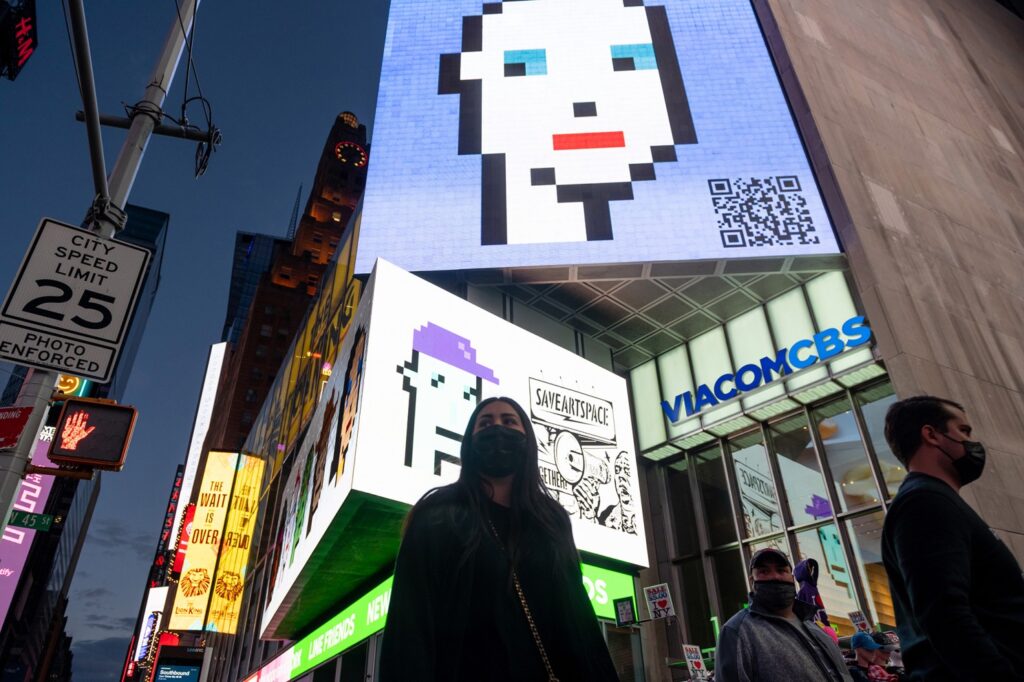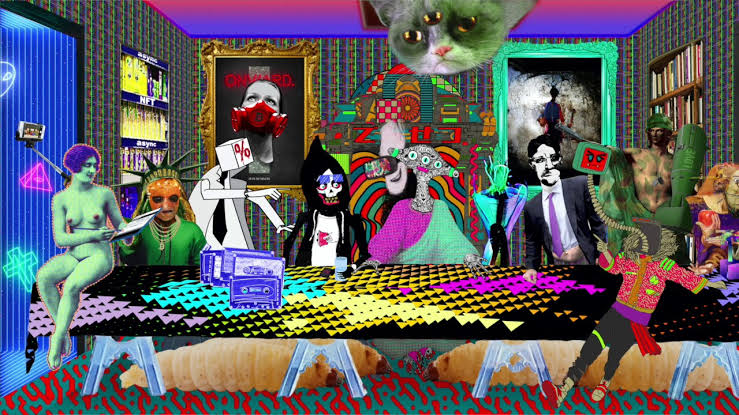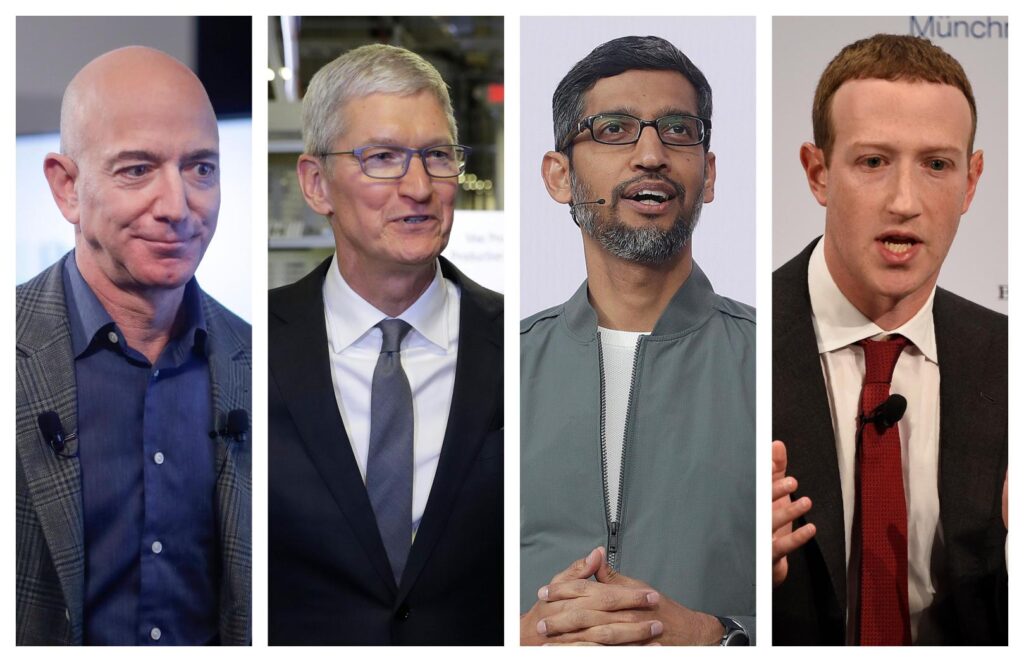DECENTRALISED ECONOMY: WHEN NFTs MERGE INTO INSTAGRAM

With the creation of Web 2.0 and its opportunities for user-generated content as well as participatory culture, many social and cultural changes have been implemented. Platformization has changed the dynamics of digital infrastructures and economic processes for good and has allowed for the creation of new business models, such as the one based on a collection of binary data, cryptocurrency. Over a decade ago, the first decentralized cryptocurrency, Bitcoin, was born. Crypto kept growing over the course of the years, which paved the way for the birth of new sorts of crypto, such as Non-Fungible Tokens (NFTs) that were born out of the visual world. NFTs are currently blooming, more and more investors are creating new revenue channels by implementing NFT assets into their business models. The most successful ones so far seem to be artists and athletes. NFTs are gaining more and more space in the markets, due to many artists commercializing their digital products, hence the transaction of these tokens is being generated more and more in online platforms, called Marketplaces (Alonso 2021). NFTs offer a huge potential to the real economy and could open up new types of marketplaces and digital ecosystems that could lead the way to Web 3.0, and perhaps change society through decentralized economies. This could pose questions such as, what would this mean to platforms? How would this reimagined decentralized economy led by NFTs change social media and its infrastructure (and our perception of them)?

Instead of showcasing personalities through Instagram profiles filled with pictures, people will showcase their NFTs as a form of social media. This is a better view of someone’s personality. If someone attended a concert, their ticket could be a limited-edition crypto-collectable that shows everyone that they were there. In the future, high-end hotels or locations could offer various crypto-collectables (Steinwold 2020).
The implementation of media formats such as cryptocurrency and platformisation could be the catalyst in what is potentially the largest transfer of wealth in the history of mankind. As we transition from Web 2.0 to Web 3.0, we are witnessing an enormous technological shift that has not occurred since the industrial revolution. A new dynamic will be created between the users and the media artefacts, as Web 3.0 will dictate different terms of interactions in online spaces. The infrastructure of these technologies will have a stark influence on the way we will behave and govern ourselves in the forthcoming years. The shift will introduce “daily immersion in the human-centric & highly personalised interactions” via coupling collective and individuals’ data with artificial intelligence (algorithms) (Mersch & Meirich, 2019). Media spaces that are more personalised and empowering are the desired goal of this transition, new infrastructures will facilitate “value and other counterparties via a substrate of peer-to-peer networks without the need for third parties. The result: a composable human-centric & privacy-preserving computing fabric for the next wave of the web.” (Mersch & Meirich 2019).

Crypto assets and Blockchains have become ubiquitous in media, the technology is regarded as a prominent figure within Web 3.0 and a vital aspect in a new ecosystem (Chandler Cryptonews 2021). The relationship between humans and technology will be redefined by this new web era, the scale and scope of the interactions will intensify: “These interactions, ranging from seamless payments to richer information flows to trusted data transfers, will become possible with a vastly increased range of potential counterparties. Web 3.0 will enable us to interact with any individual or machine in the world, without having to pass through fee-charging middlemen.” (Mersch & Meirich 2019). Self-sovereign data marketplaces and decentralised autonomous organisations will afford new business models, based on the core values of the technology.
INFRASTRUCTURE OF NFTs
NFTs belong to the fragment referred to as Blockchains, in the field of cryptocurrency.
“In essence, a blockchain is a decentralized, computerized system of identical, distributed ledgers stored across multiple nodes.” (Patrickson, 2021). The infrastructure is set up as numerous links which are identical rather than a central ledger. Via a cryptographic process, the authenticity of those ledgers is evaluated to ensure that there are not any discrepancies.
There is no involvement of third parties, such as notaries or banks, to ratify the procedure due to the security of the infrastructure of Blockchains. Assurance is “derived from the power of numbers, or collective inspection, due to the need to achieve consensus across multiple records.” (Patrickson, 2021). Blockchain enables the users to have autonomy and agency in peer-to-peer transactions. Which is interlocked with a system that affords transactions to be systematic, contracts are ratified upon transactions. “Smart contracts are coded agreements that can be programmed to automatically enact predetermined processes, like paying amount X to A, when B happens.” Via the digital smart contracts microtransactions and complex verifiable conditions are enabled. (Patrickson, 2021).
Every alteration in a former block results in alteration in all of the following blocks; it guarantees transparency and data security (Flach, 2021). This part of the infrastructure is what constitutes the decentralised network in which a central governing authority is not required. “In blockchain, social media technology further enables a system for the rewarding of users’ contributions, which in turn aims to incentivize the production of high-quality content” (Flach, 2021).
INSTAGRAM INFRASTRUCTURE
Instagram is undoubtedly one of the leading platforms in today’s digital landscape. Facebook acquired the company in 2012 for $ 1 billion, and it has been growing exponentially ever since. It has evolved from a simple photo-sharing app to a leading platform in the digital world, creating many business opportunities for big and small businesses. It has given many artists a large platform to create and share their art. With the right strategy, artists and influencers can gain enough followers to make them more recognizable to brands and enter into partnerships with them. Although Instagram states that it does not own its users’ content, the terms of agreement state something entirely different. Namely, the following: Instagram has a “non-exclusive, fully paid and royalty-free, transferable, sub-licensable, worldwide license to use their content“. Instagram can also sub-license the users’ content to third parties without asking for permission. All of this means that the content creators more or less work for free. This fact makes the platform highly centralized when it comes to the users’ ownership of the content.

With an over 60% share of all social media transactions worldwide, Facebook looks more and more like a de facto infrastructure (Plantin et al., 2018). The infrastructures of Facebook, Instagram and WhatsApp are intertwined with each other, deepening Facebook’s authority. The debate around centralized vs decentralized social media infrastructure has been going on for years. Before being bought by Facebook, Instagram was a small company with its own infrastructure. After that, the platform had to conform to Facebook’s infrastructure and became dependent on it. There are many issues concerning this topic – content ownership, data privacy or misuse of information. Centralized technology and platforms respectively make our data easily exploitable. Users are never certain that their data is kept safe and secure. The data collected by the platform is monetized without the knowledge of the user and he never sees any of these profits. For example, when users authenticate to websites or applications using their Facebook identities, the API records these acts to their Facebook data profiles.
Having access to this identity, many applications then silently contribute to the Facebook social graph via the API, extracting data from our shopping habits or information-seeking behavior and sending it along. (Plantin et al., 2018) Even if a user deletes their account, the data is still stored in the company’s internal centralized servers. Furthermore, centralized servers are more susceptible to hacking and other breaches. The 2018 data leak and the recent outage prove how fragile the infrastructure of Facebook/Instagram is. It highlighted the domino effect a centralized technology could have on a big tech company like Facebook. If one thing goes wrong, everything else falls apart as well. This occurrence raised many questions from experts in regards to infrastructure regulation. The outage highlighted the need for a decentralized infrastructure of the platform(s).
The idea behind a decentralized social media infrastructure is about the need to shift power from one single entity and to give it to the users themselves. Digital artists not getting the recognition and financial benefits they deserve is good enough reason for them to partake in the NFT craze and the idea of a decentralized economy. Many experts have been advocating for decentralized social media for years. Blockchain technology and NFTs could allow us to create a user-controlled portable identity. Decentralized technologies could enable us to create new social networks and communication tools without the disadvantages of centralization. NFTs could give artists more freedom and the opportunity to make a living from their creations.
POWER RELATION: INSTAGRAM AS AN NFT PLATFORM
It was a concerted government effort through public funding that the internet was invented. However, since the 1990s, technology has been commercialized, allowing private interest to largely dominate, at least in neoliberal Western countries (Srnicek 2016). The high-tech economy is led by giant private corporations with growing power and influence, raising concern about the clash of safeguarding societal collective good against private interest of profit making (Van Dick et al. 2018).

MONOPOLY
Consequently, the immediate concern about a decentralized NFTs on Instagram would be who would build the platform, guide its operations, and toward which direction? Instagram is a subsidiary of Facebook (now Meta Platform Inc.), and if the company is going to lead the development of the technology, it is obvious it would streamline the process in line with its business model. This means as liberating as this new technology may promise, it would still be in the hands of those with disproportionate wealth and power. The asymmetric power relation is likely to raise questions about private corporate power and its monopolistic tendencies that alter market behaviour (Katz & Shapiro 1994). This is among the concerns of the Bank for International (BIS) Settlements dubbed as the “bank for central bank” opposing crypto currencies, while advising central banks to launch government-controlled Central Banks Digital Currencies to protect public interest. BIS’s head of research and economic advisor Hyun Song Shin writes:
Authorities have recently addressed concerns about anti-competitive practices that exclude competitors in associated digital services such as e-commerce and social media. This concentration of market power is a reason why authorities in some economies are increasingly turning to an entity-based approach to regulating Big Techs. (Shin 2020: 6th para).
TRANSPARENCY
As the infrastructure and the platforms fall into the hands of private interest, transparency regarding digital traces left on the platform would be a key concern. Particularly, user privacy and the trafficking of personal data would be of concern for society. Srnicek (2016) explains that these platforms have become “an efficient way to monopolise, extract, analyse, and use the increasingly large amounts of data that are being recorded” (p. 42-43), requiring laws to guard against this kind of exploitation. Already, the Facebook–Cambridge Analytica data scandal has demonstrated the extent to which private interest can go against the public.
ACCOUNTABILITY
Further, there would be a need to demand accountability on the internal structures of these companies. For example in the current crypto currency space, there are over 300 exclusive (deal only in crypto) platforms where users can buy, sell, and exchange coins (Coinmarketcap 2021). But so far, just one—Coinbase is trading publicly on the Nasdaq exchange via a direct listing (Browne & Bursztynsky 2021). This is even at the platform exchange level. At the data mining level, it is completely in the hands of anonymous and in many cases in remote areas difficult to follow. An industry expert on digital developments at Statista, Raynor de Best who tracks bitcoin mining farms around the world, admits mining operations, owners, exact locations and other details are not entirely transparent (De Best 2021).
TRUST
Trust is the basis of our economy. Even physical cash is a credit with the debtor (giver) indirectly assuring the creditor (receiver) that the debt would be paid from the subsequent transaction that arises from the money (Pettifor 2017). This means trust is an indispensable element that ensures the smooth running of a society; thus lack of trust is inimical to societal progress. NFTs-led decentralized economy would have the enormous task of building trust and confidence on social media. In an online decentralized economy where the majority of people carry out their transactions online, online security to ensure the properties of people are safe and secure is a must. There is no doubt about this. Already in the NFTs digital art environment, some artists have reported their works being pirated and sold on different platforms (Purtill, 2021). Commenting on the insecure nature of the cryptocurrency space for an example, Chalmers (2019) says there is “the abundance of scams within the space, explaining further what is likely going to exclude people from the technology by stating “people may have made money off these altcoins, just as many people will have lost money. This will have certainly put many people off cryptocurrencies as a whole and made them believe the space is just a scam” (Chalmers 2019: n.p.). Consequently, building an NFT wallet that is secure to use and prevent fraud and scam would be a step forward.
CONVENIENCE
Another crucial task for an NFTs-led decentralized economy on social media is convenience. By convenience we mean accessibility. The scepticism of online transactions is not exclusively based on lack of trust by users, but also access and ease of use of the technology. The NFTs world is currently dominated by tech savvy individuals, raising the entry barrier, or excluding non-computer literates (Ou 2019). This is one part of the accessibility problem. The other is the access to the internet in general. In 2014, the United Nations predicted half of the world’s population would be connected to the internet, dubbing the internet “the fastest growing technology in human history” (International Telecommunication Union 2014). This goal is yet to be achieved as currently there are over 3.8 billion people offline (Dreyfuss 2018). This of course raises serious concerns for a global decentralized economy when over half of the population do not have basic connectivity, not to mention becoming tech savvy or computer literate in order to participate in this new economy.
CONCLUSION
The prospect of a new form of governance on social platforms that affords the individual user to not be at the mercy of algorithms and monopolised platform structures is enticing. However, as research shows this might only be achievable for the creators on these platforms and not for the average consumer. NFTs have gained notoriety by putting money back into the hands of the artists and those being exploited, ensuring they get paid well upon purchase but also after it gets sold on. From an economic perspective, it does present a level playing field; the question then becomes how does one position oneself. We fear, however, the same dynamic which was present in Web 2.0 will transition into Web 3.0 but just in favour of the creator and the rich. Each of their transactions made on the platform will affect and influence everybody else if this is the foundation on which the platform is built. Nothing will change for the average user, who spends time on Instagram just for leisure. A question then remains, what could be implemented for an egalitarian outcome for all users?
Co Authors:
Fanni Kovács
Lazarina Chernokozheva
Michael Ekow Ashong
Bibliography
Alonso, Kevin. 2021. “The Future of NFT’s & The Optimistic Potential of Decentralized Economies.” The Factory Interactive(blog). May 20, 2021. https://thefactoryi.com/2021/05/20/the-future-of-nfts-the-optimistic-potential-of-decentralized-economies/.
Bosher, Hayleigh. 2018. “Ten Things You Should Know about Instagram’s Terms of Use.” The Conversation. September 12, 2018. http://theconversation.com/ten-things-you-should-know-about-instagrams-terms-of-use-102800.
Browne, R and Bursztynsky, J. 2021, April 15. Coinbase stock closes down day after landmark Nasdaq debut. CNBC.https://www.cnbc.com/2021/04/15/coinbase-coin-climbs-11percent-in-premarket-after-nasdaq-debut.html
Chalmers, Ross. 2019. “Five Barriers to Cryptocurrency Adoption in the Mainstream.” 2019. https://finance.yahoo.com/news/five-barriers-cryptocurrency-adoption-mainstream-130056021.html.
Chandler, Simon. 2021. Web 3.0 Is Coming, and Crypto Will Be Essential to It
De Best, R. 2021, October 11 Distribution of Bitcoin mining hashrate from September 2019 to April 2021, by country. Statista.https://www.statista.com/statistics/1200477/bitcoin-mining-by-country/
Dreyfuss, E. 2018, Feb 23. Global Internet Access Is Even Worse Than Dire Reports Suggest. WIRED.https://www.wired.com/story/global-internet-access-dire-reports/
Everything, Blockchain. 2021. “Centralized or Decentralized Social Media – Subsocial Trying to Shake the Ground.” Subsocial Network. September 26, 2021. https://app.subsocial.network/4473/centralized-or-decentralized-social-media-subsocial-trying-20175.
Flach, Elena-Sophie. 2021 Real News: How Blockchain could Revolutionize Social Media
Hao, Jay. 2021. “Reimagine Decentralized Economy: Metaverse, NFTs & GameFi.” October 11, 2021. https://www.linkedin.com/pulse/reimagine-decentralized-economy-metaverse-nfts-gamefi-jay-hao.
Isaac, Mike. 2019. “Zuckerberg Plans to Integrate WhatsApp, Instagram and Facebook Messenger – The New York Times.” January 25, 2019. https://www.nytimes.com/2019/01/25/technology/facebook-instagram-whatsapp-messenger.html.
ITU. 2014. “Half the World Will Be Online by 2017.” September 21, 2014. https://www.itu.int/net/pressoffice/press_releases/2014/46.aspx#.W8oeBxNKjOS.
Jimenez, Daniel. 2021. “NFT: The New Decentralized Economy? | Hacker Noon.” May 2, 2021. https://hackernoon.com/nft-the-new-decentralized-economy-iem3421.
Mersch, Muirhead. 2019. What Is Web 3.0 & Why It Matters
Müller, Thomas. 2021. “How NFT and Crypto Impacts the Real Economy.” September 13, 2021. https://morethandigital.info/en/how-nft-and-crypto-impacts-the-real-economy/.
Ou, M. 2019, Feb 12. Blockchain has entry barriers. Let’s tear them down. Nasdaq.https://www.nasdaq.com/articles/blockchain-has-barriers-entry-2019-lets-tear-them-down-2019-02-12
Patrickson, B. What do blockchain technologies imply for digital creative industries? Creat Innov Manag. 2021; 30: 585– 595. https://doi-org.proxy.uba.uva.nl/10.1111/caim.12456
Pettifor, A. 2017. The production of money: how to break the power of bankers. Verso Books.
Plantin, Jean-Christophe, Carl Lagoze, Paul N Edwards, and Christian Sandvig. 2018. “Infrastructure Studies Meet Platform Studies in the Age of Google and Facebook.” New Media & Society 20 (1): 293–310. https://doi.org/10.1177/1461444816661553.
Poell, Thomas, David Nieborg and José van Dijck. 2019. “Platformisation.” Internet Policy Review 8(4): 1-13.
Purtill, J. 2021, Mar 16. Artists report discovering their work is being stolen and sold as NFTs. Australian Broadcasting Corporation. https://www.abc.net.au/news/science/2021-03-16/nfts-artists-report-their-work-is-being-stolen-and-sold/13249408
Purtill, J. 2021, Mar 16. Artists report discovering their work is being stolen and sold as NFTs. Australian Broadcasting Corporation. https://www.abc.net.au/news/science/2021-03-16/nfts-artists-report-their-work-is-being-stolen-and-sold/13249408
Shin, H.S. 2021, June 29. Central bank digital currencies: an opportunity for the monetary system Bank of International Settlement. https://www.bis.org/speeches/sp210629b.htm
SingularityNET. 2021. Decentralized Economy – NFTs and the Decentralization of Art. https://www.youtube.com/watch?v=0-R919OZKzg.
Srnicek, N. 2016. Platform capitalism. John Wiley & Sons.
Srnicek, Nick. 2017. Platform Capitalism. Cambridge, UK: Polity. (Chapter “Platform Capitalism”)
Steinwold, Andrew. July 2020 https://andrewsteinwold.substack.com/p/crypto-will-change-value-nfts-will
Van Dijck, J., Poell, T., & De Waal, M. (2018). The platform society: Public values in a connective world. Oxford University Press.